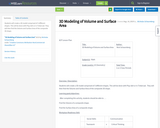
Students will create a 3D model comprised of 3 different shapes. This will be done with Play-doh or in Tinkercad. They will then find the Volume and Surface Area of the composite 3D shape.

Students will create a 3D model comprised of 3 different shapes. This will be done with Play-doh or in Tinkercad. They will then find the Volume and Surface Area of the composite 3D shape.
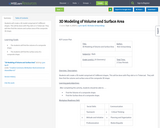
Students will create a 3D model comprised of 3 different shapes. This will be done with Play-doh or in Tinkercad. They will then find the volume and surface area of the composite 3D shape.
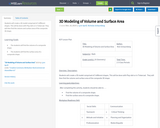
Students will create a 3D model comprised of 3 different shapes. This will be done with Play-doh or in Tinkercad. They will then find the volume and surface area of the composite 3D shape.
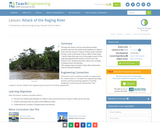
In this lesson, the students will discover the relationship between an object's mass and the amount of space it takes up (its volume). The students will also learn about the concepts of displacement and density.
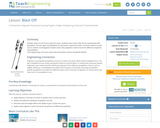
Rockets need a lot of thrust to get into space. In this lesson, students learn how rocket thrust is generated with propellant. The two types of propellants are discussed and relation to their use on rockets is investigated. Students learn why engineers need to know the different properties of propellants.
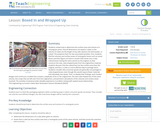
Students find the volume and surface area of a rectangular box (e.g., a cereal box), and then figure out how to convert that box into a new, cubical box having the same volume as the original. As they construct the new, cube-shaped box from the original box material, students discover that the cubical box has less surface area than the original, and thus, a cube is a more efficient way to package things. Students then consider why consumer goods generally aren't packaged in cube-shaped boxes, even though they would require less material to produce and ultimately, less waste to discard. To display their findings, each student designs and constructs a mobile that contains a duplicate of his or her original box, the new cube-shaped box of the same volume, the scraps that are left over from the original box, and pertinent calculations of the volumes and surface areas involved. The activities involved provide valuable experience in problem solving with spatial-visual relationships.
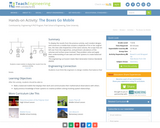
To display the results from the previous activity, each student designs and constructs a mobile that contains a duplicate of his or her original box, the new cube-shaped box of the same volume, the scraps that are left over from the original box, and pertinent calculations of the volumes and surface areas involved. They problem solve and apply their understanding of see-saws and lever systems to create balanced mobiles.

This lesson helps students develop spatial visualization skills and geometric understanding by exploring the different nets that can be folded into a cube. The lesson is placed in the context of a young woman who is trying to build a jewelry box. The lesson provides an activity sheet, a link to a helpful applet (Cube Nets, cataloged separately), questions for students and teachers, and ideas for assessment and extensions.
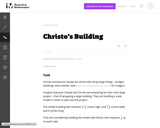
This task is primarily about volume and surface area, although it also gives students an early look at converting between measurements in scale models and the real objects they correspond to.
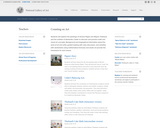
In these lessons students will explore the paintings of Horace Pippin and Wayne Thiebaud and the mobiles of Alexander Calder to discover and practice math and visual art concepts. Background and biographical information about the work of art and artist, guided looking with class discussion, and activities with worksheets using mathematical formulas and studio art provide the framework for each lesson.
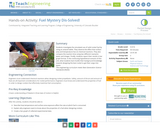
In this activity, students investigate the simulated use of solid rocket fuel by using an antacid tablet. Students observe the effect that surface area and temperature has on chemical reactions. Also, students compare the reaction time using two different reactants: water and vinegar. Finally, students report their results using a bar graph.

While learning about volcanoes, magma and lava flows, students learn about the properties of liquid movement, coming to understand viscosity and other factors that increase and decrease liquid flow. They also learn about lava composition and its risk to human settlements.
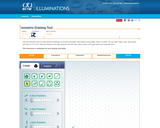
This Java interactive tool can be used to create dynamic drawings on an isometric dot grid, and to explore volume, surface area, and congruence concepts. Users can draw figures using edges, faces, or cubes and can shift, rotate, color, decompose, and view figures in 2‑D or 3‑D with this applet. Instructions on using and exploring with the tool are included on the page. A related multi-lesson unit from Illuminations for middle school students is linked to the side.

This lesson explores the drag force on airplanes. The students will be introduced to the concept of conservation of energy and how it relates to drag. Students will explore the relationship between drag and the shape, speed and size of an object.
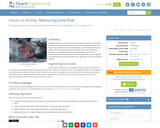
Students learn how volume, viscosity and slope are factors that affect the surface area that lava covers. Using clear transparency grids and liquid soap, students conduct experiments, make measurements and collect data. They also brainstorm possible solutions to lava flow problems as if they were geochemical engineers, and come to understand how the properties of lava are applicable to other liquids.
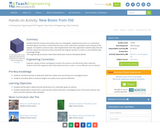
Students find the volume and surface area of a rectangular box (e.g., a cereal box), and then figure out how to convert that box into a new, cubical box having the same volume as the original. As they construct the new, cube-shaped box from the original box material, students discover that the cubical box has less surface area than the original, and thus, a cube is a more efficient way to package things.
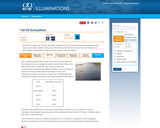
This math meets ecology lesson provides hands-on experiences with mixing oil and water, provides surface area information about the 2010 oil spill in the Gulf of Mexico, and gives learners opportunities to estimate small oil spills of their own making. This lesson guide includes questions for learners, assessment options, extensions, and reflection questions.
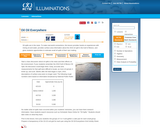
This math meets ecology lesson provides hands-on experiences with mixing oil and water, provides surface area information about the 2010 oil spill in the Gulf of Mexico, and gives learners opportunities to estimate small oil spills of their own making. This lesson guide includes questions for learners, assessment options, extensions, and reflection questions.

Students will use the geometric formula for finding the surface area of a regular square pyramid.
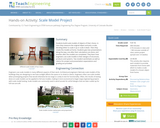
Students build scale models of objects of their choice. In class they measure the original object and pick a scale, deciding either to scale it up or scale it down. Then they create the models at home. Students give two presentations along the way, one after their calculations are done, and another after the models are completed. They learn how engineers use scale models in their designs of structures, products and systems. Two student worksheets as well as rubrics for project and presentation expectations and grading are provided.